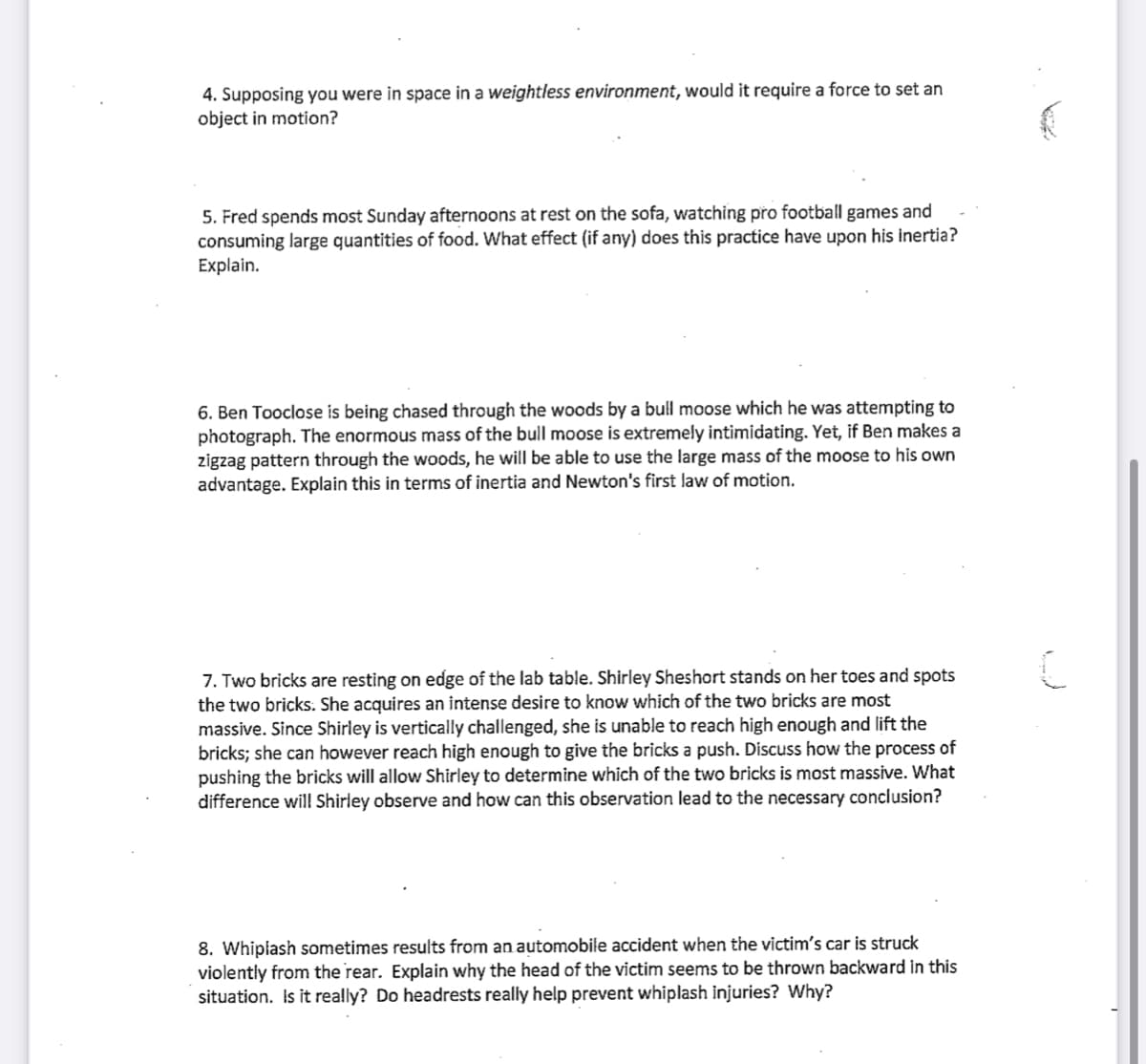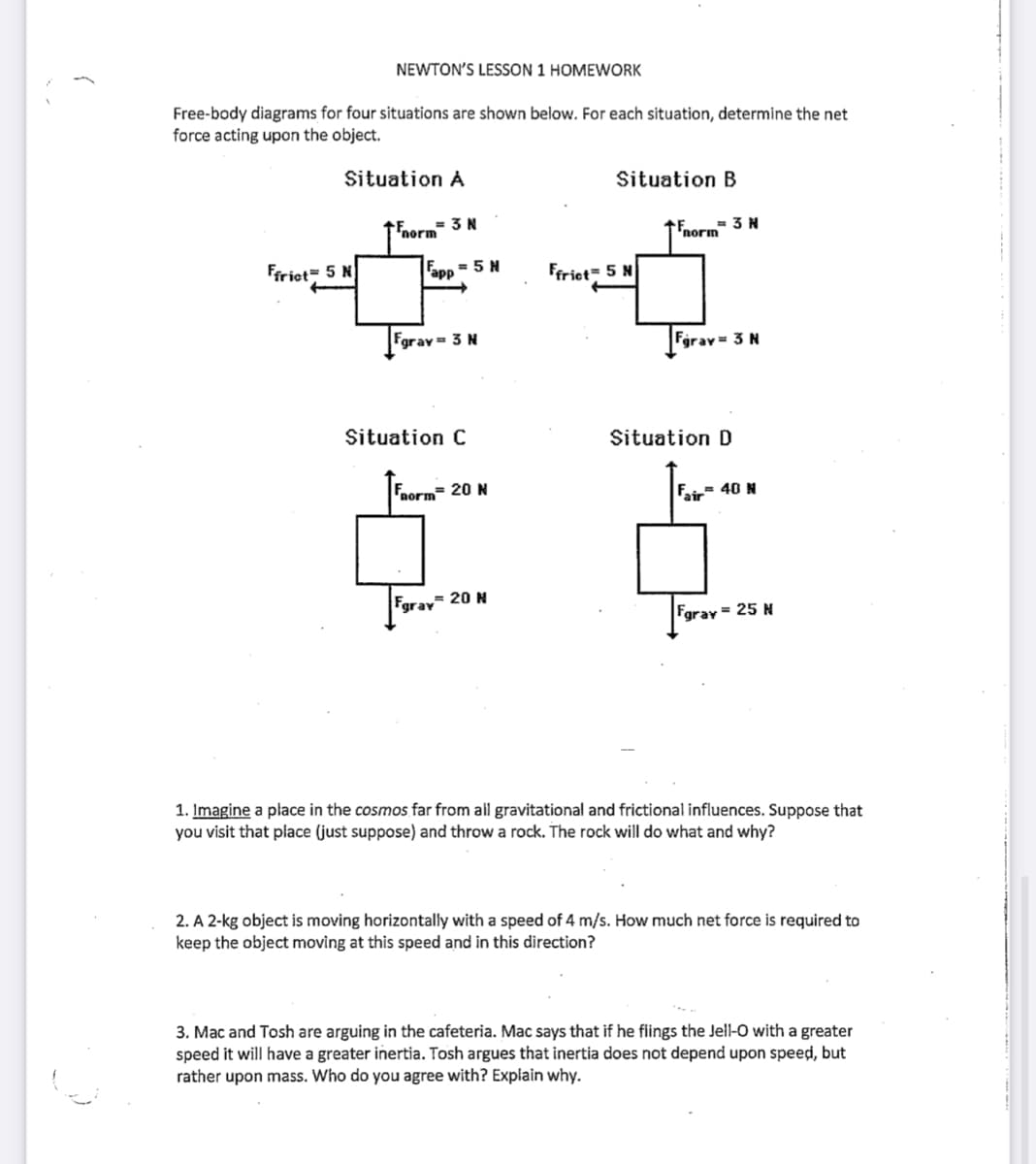NEWTON'S LESSON 1 HOMEWORK Free-body diagrams for four situations are shown below. For each situation, determine the net force acting upon the object. Situation A Ffrict 5 N ↑Fnorm =3N Fapp = 5 N Fgray = 3 N Situation C Form= 20 N Fgray 20 N Situation B Ffrict 5 N <=3N norm Fgrav=3 N Situation D Fair 40 N Fgray = 25 N 1. Imagine a place in the cosmos far from all gravitational and frictional influences. Suppose that you visit that place (just suppose) and throw a rock. The rock will do what and why? 2. A 2-kg object is moving horizontally with a speed of 4 m/s. How much net force is required to keep the object moving at this speed and in this direction? 3. Mac and Tosh are arguing in the cafeteria. Mac says that if he flings the Jell-O with a greater speed it will have a greater inertia. Tosh argues that inertia does not depend upon speed, but rather upon mass. Who do you agree with? Explain why.
NEWTON'S LESSON 1 HOMEWORK Free-body diagrams for four situations are shown below. For each situation, determine the net force acting upon the object. Situation A Ffrict 5 N ↑Fnorm =3N Fapp = 5 N Fgray = 3 N Situation C Form= 20 N Fgray 20 N Situation B Ffrict 5 N <=3N norm Fgrav=3 N Situation D Fair 40 N Fgray = 25 N 1. Imagine a place in the cosmos far from all gravitational and frictional influences. Suppose that you visit that place (just suppose) and throw a rock. The rock will do what and why? 2. A 2-kg object is moving horizontally with a speed of 4 m/s. How much net force is required to keep the object moving at this speed and in this direction? 3. Mac and Tosh are arguing in the cafeteria. Mac says that if he flings the Jell-O with a greater speed it will have a greater inertia. Tosh argues that inertia does not depend upon speed, but rather upon mass. Who do you agree with? Explain why.
College Physics
1st Edition
ISBN:9781938168000
Author:Paul Peter Urone, Roger Hinrichs
Publisher:Paul Peter Urone, Roger Hinrichs
Chapter4: Dynamics: Force And Newton's Laws Of Motion
Section: Chapter Questions
Problem 24PE: The wheels of a midsize car exert a force of 2100 N backward on the road to accelerate the car in...
Related questions
Topic Video
Question
Hello, can you please help me with my homework

Transcribed Image Text:4. Supposing you were in space in a weightless environment, would it require a force to set an
object in motion?
5. Fred spends most Sunday afternoons at rest on the sofa, watching pro football games and
consuming large quantities of food. What effect (if any) does this practice have upon his inertia?
Explain.
6. Ben Tooclose is being chased through the woods by a bull moose which he was attempting to
photograph. The enormous mass of the bull moose is extremely intimidating. Yet, if Ben makes a
zigzag pattern through the woods, he will be able to use the large mass of the moose to his own
advantage. Explain this in terms of inertia and Newton's first law of motion.
7. Two bricks are resting on edge of the lab table. Shirley Sheshort stands on her toes and spots
the two bricks. She acquires an intense desire to know which of the two bricks are most
massive. Since Shirley is vertically challenged, she is unable to reach high enough and lift the
bricks; she can however reach high enough to give the bricks a push. Discuss how the process of
pushing the bricks will allow Shirley to determine which of the two bricks is most massive. What
difference will Shirley observe and how can this observation lead to the necessary conclusion?
8. Whiplash sometimes results from an automobile accident when the victim's car is struck
violently from the rear. Explain why the head of the victim seems to be thrown backward in this
situation. Is it really? Do headrests really help prevent whiplash injuries? Why?

Transcribed Image Text:NEWTON'S LESSON 1 HOMEWORK
Free-body diagrams for four situations are shown below. For each situation, determine the net
force acting upon the object.
Situation A
Ffrict 5 N
= 3 N
Fnorm
app = 5 H
Fgray = 3 N
Situation C
Form= 20 N
Fgray= 20 N
Situation B
Ffrict 5 N
= 3 N
Fnorm
Fgrav= 3 N
Situation D
Fair 40 N
Fgray = 25 N
1. Imagine a place in the cosmos far from all gravitational and frictional influences. Suppose that
you visit that place (just suppose) and throw a rock. The rock will do what and why?
2. A 2-kg object is moving horizontally with a speed of 4 m/s. How much net force is required to
keep the object moving at this speed and in this direction?
3. Mac and Tosh are arguing in the cafeteria. Mac says that if he flings the Jell-O with a greater
speed it will have a greater inertia. Tosh argues that inertia does not depend upon speed, but
rather upon mass. Who do you agree with? Explain why.
Expert Solution
This question has been solved!
Explore an expertly crafted, step-by-step solution for a thorough understanding of key concepts.
This is a popular solution!
Trending now
This is a popular solution!
Step by step
Solved in 5 steps

Knowledge Booster
Learn more about
Need a deep-dive on the concept behind this application? Look no further. Learn more about this topic, physics and related others by exploring similar questions and additional content below.Recommended textbooks for you

College Physics
Physics
ISBN:
9781938168000
Author:
Paul Peter Urone, Roger Hinrichs
Publisher:
OpenStax College

University Physics Volume 1
Physics
ISBN:
9781938168277
Author:
William Moebs, Samuel J. Ling, Jeff Sanny
Publisher:
OpenStax - Rice University

Physics for Scientists and Engineers: Foundations…
Physics
ISBN:
9781133939146
Author:
Katz, Debora M.
Publisher:
Cengage Learning

College Physics
Physics
ISBN:
9781938168000
Author:
Paul Peter Urone, Roger Hinrichs
Publisher:
OpenStax College

University Physics Volume 1
Physics
ISBN:
9781938168277
Author:
William Moebs, Samuel J. Ling, Jeff Sanny
Publisher:
OpenStax - Rice University

Physics for Scientists and Engineers: Foundations…
Physics
ISBN:
9781133939146
Author:
Katz, Debora M.
Publisher:
Cengage Learning

Glencoe Physics: Principles and Problems, Student…
Physics
ISBN:
9780078807213
Author:
Paul W. Zitzewitz
Publisher:
Glencoe/McGraw-Hill
